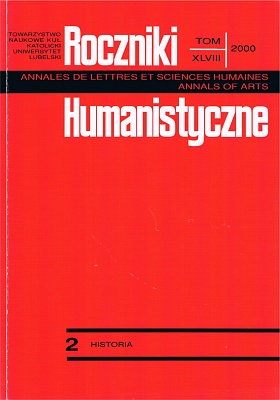Organy i organiści w okręgu wiślickim w XVIII w. na podstawie akt wizytacyjnych
Abstrakt
In the 18th century organs rapidly became popular in the Wiślica district. It has been found that most organs built then were small instruments in today's understanding. They consisted of positives without pedals. As far as the names are concerned it seems like the organs were a bigger instrument than the positive, especially with respect to the number of voices. Studies of the number of voices have shown that the number of instruments called `organs' and `positive' was equal, with the range of voices between six and nine. The most typical place where organs were put was the organ loft, which was at the back of the church, over the main door: 75.5% of the organs stood there. The inspections do not give much information about the construction details of the organs. With respect to the bellows most often their number was mentioned: it was 2, 4 or 6. Pedals were mentioned in two parishes but it may be assumed that there were more of them. It has been found that the percentage of portable instruments decreased – in the first half of the 18th century from 20 to 17.6%, and this process was especially rapid in the second half of the 18th century: from 17.6 to 7.7%. This proves a decrease in popularity of this kind of organs.
During the 18th century the number of organists increased, which was probably related to the increase in the number of organs. If at the beginning of the 18th century the number of organists in relation to the number of inspected churches was a little above 60%, it increased to 90% in the middle of that century, and at the end of it it was probably 100%. The organists only had the names of Christian saints or ones that appeared in the Old Testament. They represented all age groups. Most often they were between 40 and 55 years old, and the average age was 42. The organist often had also the function of chanter, teacher, sacristan or bell-ringer. He was usually given a whole house, received payment in money, sometimes fairly big, and a strip of land or garden to maintain.
Bibliografia
Chodyński S., Organy, muzyka i śpiew w kościele katedralnym włocławskim, Włocławek 1902.
Chwałek J., Budowa organów, cz. 1, Warszawa 1971.
Chwałek J., XVIII-wieczne organy kościoła farnego w Kazimierzu Dolnym, Lublin 1979, cz. 1-3, mps B KUL.
Gołos J., Polskie organy i muzyka organowa, Warszawa 1972.
Gołos J., Zarys historii budowy organów w Polsce, Bydgoszcz 1966.
Litak S., Struktura i funkcje społeczne parafii w Polsce, w: Kościół w Polsce, t. II, Kraków 1972.
Sapalski A., Przewodnik dla organistów, Kraków 1800.
Wiśniowski E., Prepozytura wiślicka do schyłku XVIII w., w: Materiały do atlasu historycznego chrześcijaństwa w Polsce, t. XI/2 Lublin 1976.
Wyczawski H., Wprowadzenie do studiów w archiwach kościelnych, Warszawa 1956.
Żabiński Z., Systemy pieniężne na ziemiach polskich, Wrocław 1981.
Copyright (c) 2000 Roczniki Humanistyczne

Utwór dostępny jest na licencji Creative Commons Uznanie autorstwa – Użycie niekomercyjne – Bez utworów zależnych 4.0 Międzynarodowe.





